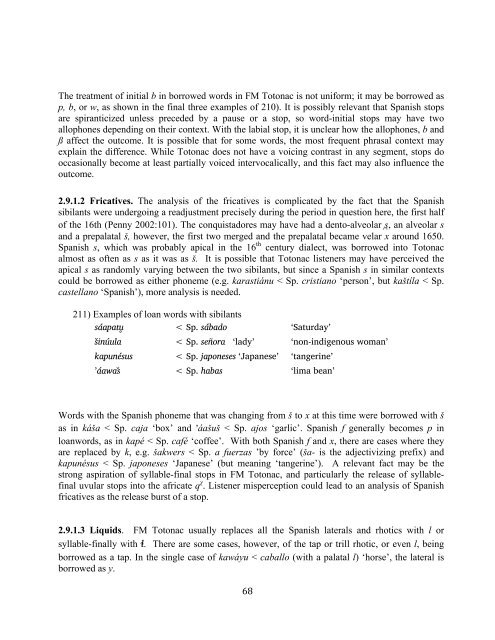The phonology and morphology of Filomeno Mata Totonac
The phonology and morphology of Filomeno Mata Totonac
The phonology and morphology of Filomeno Mata Totonac
You also want an ePaper? Increase the reach of your titles
YUMPU automatically turns print PDFs into web optimized ePapers that Google loves.
<strong>The</strong> treatment <strong>of</strong> initial b in borrowed words in FM <strong>Totonac</strong> is not uniform; it may be borrowed as<br />
p, b, or w, as shown in the final three examples <strong>of</strong> 210). It is possibly relevant that Spanish stops<br />
are spiranticized unless preceded by a pause or a stop, so word-initial stops may have two<br />
allophones depending on their context. With the labial stop, it is unclear how the allophones, b <strong>and</strong><br />
ß affect the outcome. It is possible that for some words, the most frequent phrasal context may<br />
explain the difference. While <strong>Totonac</strong> does not have a voicing contrast in any segment, stops do<br />
occasionally become at least partially voiced intervocalically, <strong>and</strong> this fact may also influence the<br />
outcome.<br />
2.9.1.2 Fricatives. <strong>The</strong> analysis <strong>of</strong> the fricatives is complicated by the fact that the Spanish<br />
sibilants were undergoing a readjustment precisely during the period in question here, the first half<br />
<strong>of</strong> the 16th (Penny 2002:101). <strong>The</strong> conquistadores may have had a dento-alveolar s", an alveolar s<br />
<strong>and</strong> a prepalatal #, however, the first two merged <strong>and</strong> the prepalatal became velar x around 1650.<br />
Spanish s, which was probably apical in the 16 th century dialect, was borrowed into <strong>Totonac</strong><br />
almost as <strong>of</strong>ten as s as it was as #. It is possible that <strong>Totonac</strong> listeners may have perceived the<br />
apical s as r<strong>and</strong>omly varying between the two sibilants, but since a Spanish s in similar contexts<br />
could be borrowed as either phoneme (e.g. karastiánu < Sp. cristiano ‘person’, but ka#tíla < Sp.<br />
castellano ‘Spanish’), more analysis is needed.<br />
211) Examples <strong>of</strong> loan words with sibilants<br />
sáapatu& < Sp. sábado ‘Saturday’<br />
s%inúula < Sp. señora ‘lady’ ‘non-indigenous woman’<br />
kapunésus < Sp. japoneses ‘Japanese’ ‘tangerine’<br />
’áawas" < Sp. habas ‘lima bean’<br />
Words with the Spanish phoneme that was changing from # to x at this time were borrowed with #<br />
as in ká#a < Sp. caja ‘box’ <strong>and</strong> ’áa#u# < Sp. ajos ‘garlic’. Spanish f generally becomes p in<br />
loanwords, as in kapé < Sp. café ‘c<strong>of</strong>fee’. With both Spanish f <strong>and</strong> x, there are cases where they<br />
are replaced by k, e.g. #akwers < Sp. a fuerzas ’by force’ (#a- is the adjectivizing prefix) <strong>and</strong><br />
kapunésus < Sp. japoneses ‘Japanese’ (but meaning ‘tangerine’). A relevant fact may be the<br />
strong aspiration <strong>of</strong> syllable-final stops in FM <strong>Totonac</strong>, <strong>and</strong> particularly the release <strong>of</strong> syllablefinal<br />
uvular stops into the africate q ( . Listener misperception could lead to an analysis <strong>of</strong> Spanish<br />
fricatives as the release burst <strong>of</strong> a stop.<br />
2.9.1.3 Liquids. FM <strong>Totonac</strong> usually replaces all the Spanish laterals <strong>and</strong> rhotics with l or<br />
syllable-finally with ". <strong>The</strong>re are some cases, however, <strong>of</strong> the tap or trill rhotic, or even l, being<br />
borrowed as a tap. In the single case <strong>of</strong> kawáyu < caballo (with a palatal l) ‘horse’, the lateral is<br />
borrowed as y.<br />
! *,!

















